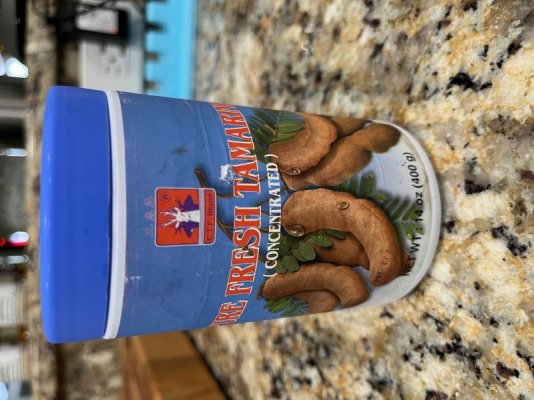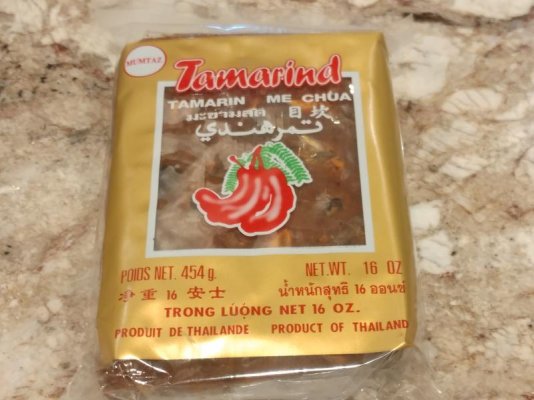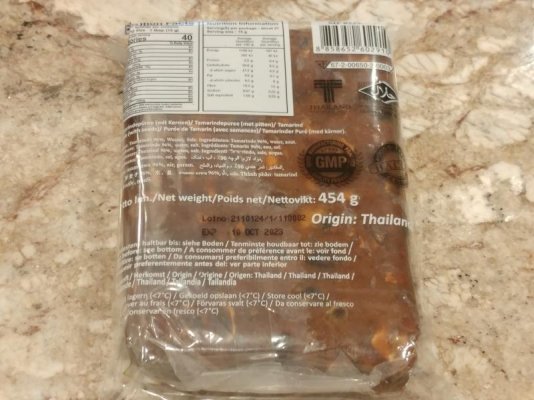I have recently tasted a tamarind sauce and a tamarind chutney. Both were delicious. I have been reading up on it. Who here uses tamarind? What form do you use? Please tell me about your experience using tamarind.
You are using an out of date browser. It may not display this or other websites correctly.
You should upgrade or use an alternative browser.
You should upgrade or use an alternative browser.
Tamarind
- Thread starter taxlady
- Start date
The friendliest place on the web for anyone that enjoys cooking.
If you have answers, please help by responding to the unanswered posts.
If you have answers, please help by responding to the unanswered posts.
larry_stewart
Master Chef
Ive used it both fresh and concentrated .
I havant used it in awhile ( Years)
The fresh come in these large pods. I would use them to make like a tamarind drink. You have to break open the pods ( which is easy, they kinda crack open). Inside is like a sticky tamarind paste + large seeds and these fibers. I used to mix it with water and sugar ( I think I heated up the water so the paste would dissolve and come off the seeds easier).
As far as the concentrate, I remember several Asian cuisines and Indian cusines would require a spoon or two in their sauces or soups.
I remember watching a recipe on YouTube, and they referred to the tamarind as " Sour Raisin". which kinda describes it pretty good.
Very tangy, but not as much so as a lemon ( although the concentrate is ( because it is concentrated ).
Most recipes with it in it (that Ive come across). call for he concentrated version.( much easier than dealing with the outer shell and seeds).
Hope this added a little insight.
I havant used it in awhile ( Years)
The fresh come in these large pods. I would use them to make like a tamarind drink. You have to break open the pods ( which is easy, they kinda crack open). Inside is like a sticky tamarind paste + large seeds and these fibers. I used to mix it with water and sugar ( I think I heated up the water so the paste would dissolve and come off the seeds easier).
As far as the concentrate, I remember several Asian cuisines and Indian cusines would require a spoon or two in their sauces or soups.
I remember watching a recipe on YouTube, and they referred to the tamarind as " Sour Raisin". which kinda describes it pretty good.
Very tangy, but not as much so as a lemon ( although the concentrate is ( because it is concentrated ).
Most recipes with it in it (that Ive come across). call for he concentrated version.( much easier than dealing with the outer shell and seeds).
Hope this added a little insight.
taxy, I bought my tamarind paste at one of the ethnic shops near you. Don't remember which, believe most of them are closed now other than the Asian one we went to.
That being said, I've used it rarely, it is still in the fridge, last time I looked it was still good. I never kept it in the fridge until just recently - was always in the cupboard. Have no idea why I changed.
That being said, I've used it rarely, it is still in the fridge, last time I looked it was still good. I never kept it in the fridge until just recently - was always in the cupboard. Have no idea why I changed.
karadekoolaid
Head Chef
I use tamarind frequently, since I cook a lot of Indian and SE Asian food. As a drink, with added sugar, it´s deliciously refreshing. Used in cooking, it adds an acidic, slightly sour note to dishes which are often balanced with sweet and hot; an authentic Vindaloo, for example, an Indonesian rudjak or a Thai pad thai.
I usually buy tamarind in a block; the outer husk has been removed, the pulp and the seeds remain.
As others have said, soak the tamarind in a bowl of warm water for about 30 minutes. It´s useful to break up the block with your fingers, once you put the water in.Then just pour the contents of the bowl into a sieve and press down on the solids, which will help extract most of the pulp. Add a couple of tablespoons of water if necessary to loosen the pulp. Once this is done, you´ll be left with the tamarind pits and a lot of fibre, which can all be discarded.You now have tamarind pulp. You can store this in jar in the fridge.
Tamarind chutney is a wonderful accompaniment to samosas, fried snacks, turnovers or savoury pastries. If you´d like a recipe, I´d be happy to post mine.
I usually buy tamarind in a block; the outer husk has been removed, the pulp and the seeds remain.
As others have said, soak the tamarind in a bowl of warm water for about 30 minutes. It´s useful to break up the block with your fingers, once you put the water in.Then just pour the contents of the bowl into a sieve and press down on the solids, which will help extract most of the pulp. Add a couple of tablespoons of water if necessary to loosen the pulp. Once this is done, you´ll be left with the tamarind pits and a lot of fibre, which can all be discarded.You now have tamarind pulp. You can store this in jar in the fridge.
Tamarind chutney is a wonderful accompaniment to samosas, fried snacks, turnovers or savoury pastries. If you´d like a recipe, I´d be happy to post mine.
Silversage
Head Chef
I use it frequently - mostly in Asian food. It’s absolutely essential to pad Thai. Some people try to sub lime juice, soy sauce, and sugar for the tamarind, fish sauce, and palm sugar, but it’s really not the same.
Here’s how I bought it last time in the Asian market, but I’ve used it different ways. I can often find the whole beans in the grocery, but that’s too much trouble!
Here’s how I bought it last time in the Asian market, but I’ve used it different ways. I can often find the whole beans in the grocery, but that’s too much trouble!
Attachments
Andy M.
Certified Pretend Chef
I use it for Asian dishes. I buy it either in a block of thick sticky pressed tamarind that has to be soaked in hot water and strained. I use this for pad thai. I also have a jar of tamarind concentrate for use in stir-frys etc.
blissful
Master Chef
- Joined
- Mar 25, 2008
- Messages
- 6,334
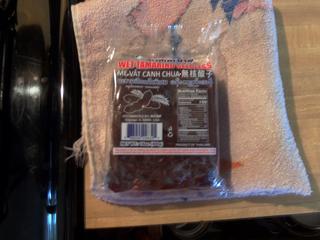
These 14 oz wet packs of tamarind are less then $4.
I bought it and then followed a website direction, add water, cook it, then strain it or put it through a food mill. I thought the mill was kind of a lot of work and messy and didn't work that well. Just straining it is probably better. It is a very unattractive process.
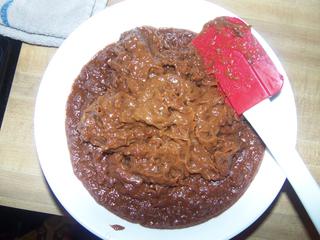
Thanks for all the replies. I have seen the instructions, and even a video, on how to get the paste out of the block of smooshed tamarind.
I want to hear how people use it. I want to hear about people's experience of how long the paste will be good in the fridge. If the paste bought as paste is as good as the stuff that people are extracting from the blocks of tamarind. I want to hear about any weirdness in using it? Are there gotchas? Is there anything I should know about choosing a block of tamarind or an already made paste? Do some of those have additional ingredients? Is it better or worse from some countries or brands?
I want to hear how people use it. I want to hear about people's experience of how long the paste will be good in the fridge. If the paste bought as paste is as good as the stuff that people are extracting from the blocks of tamarind. I want to hear about any weirdness in using it? Are there gotchas? Is there anything I should know about choosing a block of tamarind or an already made paste? Do some of those have additional ingredients? Is it better or worse from some countries or brands?

These 14 oz wet packs of tamarind are less then $4.
I bought it and then followed a website direction, add water, cook it, then strain it or put it through a food mill. I thought the mill was kind of a lot of work and messy and didn't work that well. Just straining it is probably better. It is a very unattractive process.It basically looks like bowl of...

"It basically looks like bowl of..."

Thank you for mentioning the food mill. I was wondering if it would be a good idea. One site I looked at said to put it through a colander and then, if not completely smooth, put it through a sieve. They also said "Depending on how well you've extracted flesh from the seeds and skins, you might want to re-soak the remnants in a smaller volume of hot water and make a second pass of mashing and squeezing. I do usually do this."
pepperhead212
Executive Chef
I use both types of tamarind - usually the wet block type for the Thai recipes, because the flavor is better. The concentrate I use in most Indian dishes, when the flavor doesn't seem to come through as much, and it's more the sour I'm looking for. The concentrates I've gotten from Thailand seem to get an off flavor when stored for too long, but I haven't tried vacuum sealing it in a mason jar. Never had this with the Indian tamarind concentrate. It really doesn't take that much effort to soften the paste, and press it through a medium fine strainer. And don't believe that bit about them being "seedless" - you can see the yellowish specks in the brown paste.
I re-seal the paste block in the vacuum sealed bag, since I don't use it as often as I used to, and it keeps forever in the fridge.
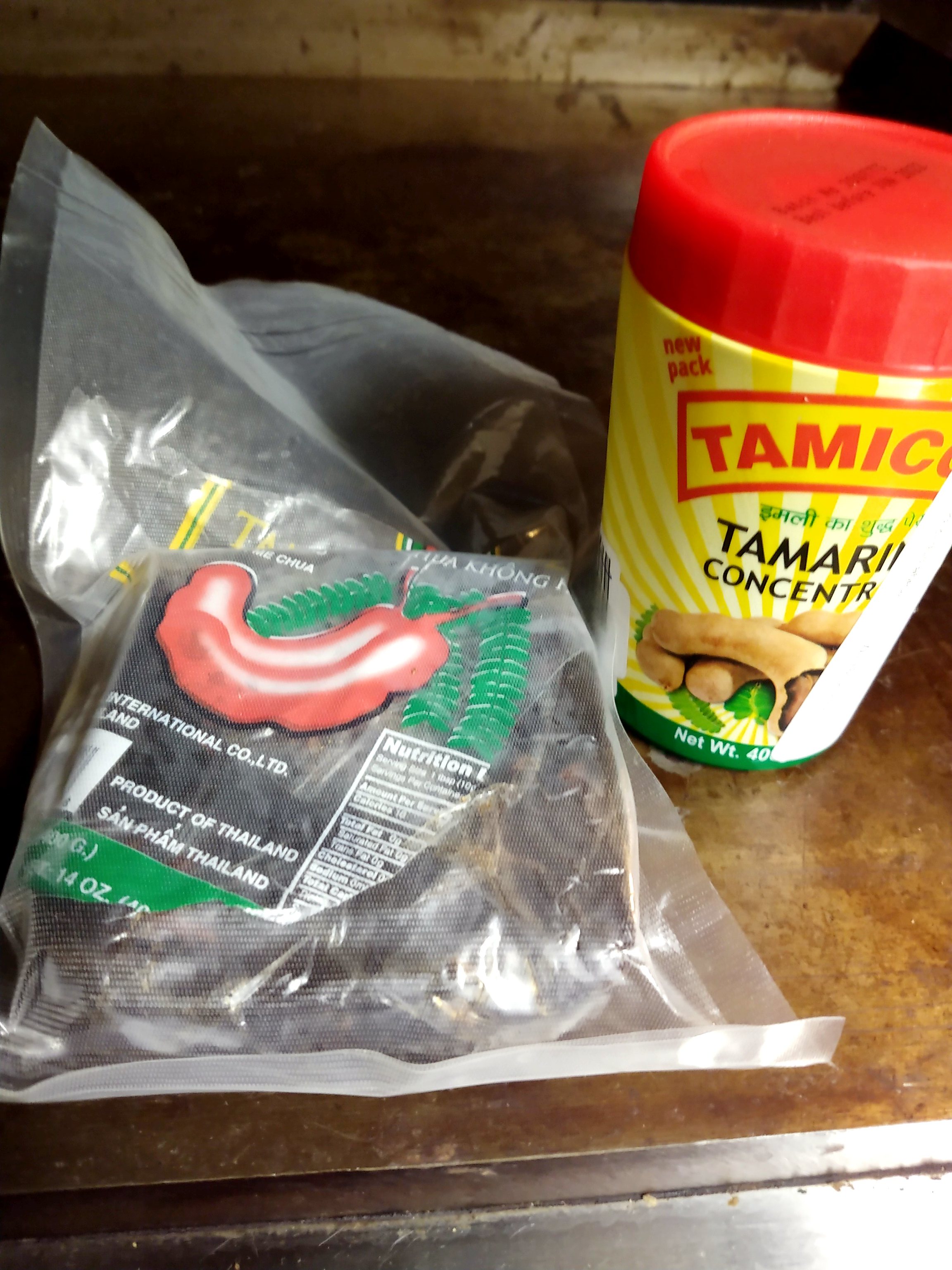 Types of tamarind I use, the one on the right the Indian concentrate. by pepperhead212, on Flickr
Types of tamarind I use, the one on the right the Indian concentrate. by pepperhead212, on Flickr
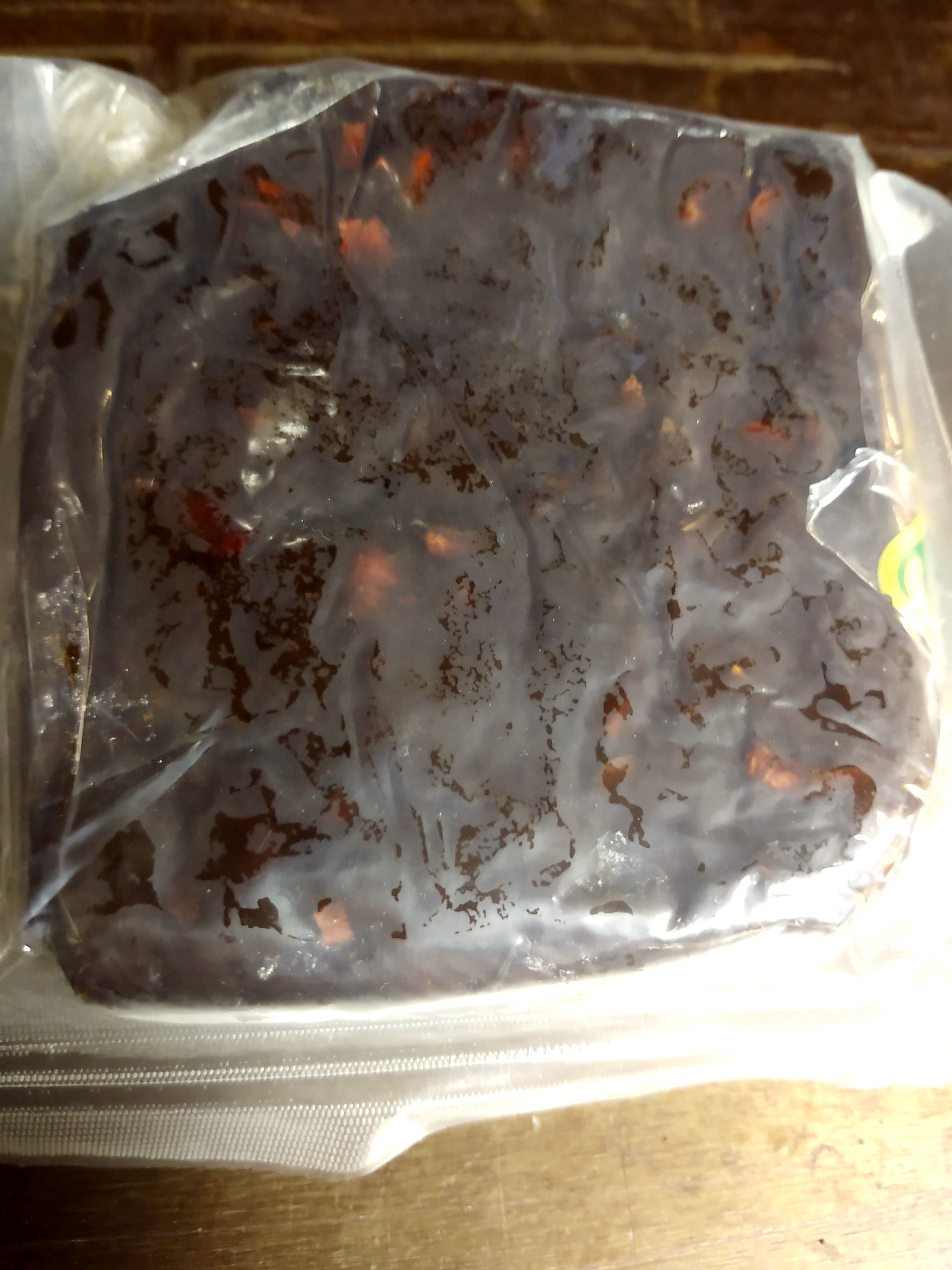 So called seedless tamarind, that needs soaked, in some warm water, and pressed through a strainer. by pepperhead212, on Flickr
So called seedless tamarind, that needs soaked, in some warm water, and pressed through a strainer. by pepperhead212, on Flickr
There is also tamarind powder out there, that is occasionally called for, but rarely.
I've also seen it occasionally in Mexican dishes, and the first place I saw a tamarind beverage was in a restaurant where mostly Mexican workers would get their lunches. It was unusual, but very good.
karadekoolaid
I'd love to see some of your chutney recipes! Thanks in advance!
I re-seal the paste block in the vacuum sealed bag, since I don't use it as often as I used to, and it keeps forever in the fridge.
 Types of tamarind I use, the one on the right the Indian concentrate. by pepperhead212, on Flickr
Types of tamarind I use, the one on the right the Indian concentrate. by pepperhead212, on Flickr So called seedless tamarind, that needs soaked, in some warm water, and pressed through a strainer. by pepperhead212, on Flickr
So called seedless tamarind, that needs soaked, in some warm water, and pressed through a strainer. by pepperhead212, on FlickrThere is also tamarind powder out there, that is occasionally called for, but rarely.
I've also seen it occasionally in Mexican dishes, and the first place I saw a tamarind beverage was in a restaurant where mostly Mexican workers would get their lunches. It was unusual, but very good.
karadekoolaid
I'd love to see some of your chutney recipes! Thanks in advance!
Great post Dave. Thank you.
You mentioned that you are going mostly for the sour. I bought some amchoor for some recipe I wanted to try. DH ordered it on Amazon. By the time it arrived, I forgot what the recipe was. I know it is sour. Do you use amchoor?
You mentioned that you are going mostly for the sour. I bought some amchoor for some recipe I wanted to try. DH ordered it on Amazon. By the time it arrived, I forgot what the recipe was. I know it is sour. Do you use amchoor?
larry_stewart
Master Chef
I actually use amchoor in some of my Indian cooking. It kinda gives that " lemony tang" without the lemon flavor. usually put it I towards the end when I want the flavors to ' pop' a bit,
To me Tamarind has a similar tanginess, but also has a more distinct flavor behind it.
I used to always make a Tamarind Cold drink. Tamarind + water + Sugar. To me it tasted kinda like a mx between lemonade and iced tea. They actually sell tamarind drink in a can at the Asian market I go to, and occasionally ill pick a can up to dring on the way home.
To me Tamarind has a similar tanginess, but also has a more distinct flavor behind it.
I used to always make a Tamarind Cold drink. Tamarind + water + Sugar. To me it tasted kinda like a mx between lemonade and iced tea. They actually sell tamarind drink in a can at the Asian market I go to, and occasionally ill pick a can up to dring on the way home.
pepperhead212
Executive Chef
Great post Dave. Thank you.
You mentioned that you are going mostly for the sour. I bought some amchoor for some recipe I wanted to try. DH ordered it on Amazon. By the time it arrived, I forgot what the recipe was. I know it is sour. Do you use amchoor?
Yes, amchoor is another ingredient that I often use to get the sour. There are a number of other sour ingredients used in Indian cooking, but these are the ones used the most - amchoor more in northern areas, tamarind in the south. Amchoor is simply unripe mangoes, dried and ground. I often use that in non-Indian dishes, to add a sour aspect, when I don't want a vinegar flavor. I guess citric acid could be used in the same way.
Last edited:
buckytom
Chef Extraordinaire
So I had some questions about the spice tamarind, but after reading this thread, I think I have a few answers.
My wife asked me to make the mung bean glass noodle Pad Thai recipe again this weekend. I ran out of the tiny bit of a jar of Tamarind paste that I had saved, and after looking in my local supermarkets, I can only find tamarind nectar in a can.
Is there any chance that I can sub tamarind nectar, or modify it enough to be useful in Pad Thai? Or should I just make the trip to an Asian market in the morning to look for fresh, or paste/concentrate.
My wife asked me to make the mung bean glass noodle Pad Thai recipe again this weekend. I ran out of the tiny bit of a jar of Tamarind paste that I had saved, and after looking in my local supermarkets, I can only find tamarind nectar in a can.
Is there any chance that I can sub tamarind nectar, or modify it enough to be useful in Pad Thai? Or should I just make the trip to an Asian market in the morning to look for fresh, or paste/concentrate.
larry_stewart
Master Chef
The tamarind nectar ( or at least he one I get at the Asian store or a Goya product) is a sweet drink. The sweetness is significant when compared to the tamarind paste, which its concentrated, pasty, sour and very tangy.
Substituting the nectar for the paste would be similar to substituting Lemonade for a squeezed lemon.
I would go to the Asian Market.
***That being said, I actually often get the tamarind nectar to drink on the way home from shopping. I like I a lot***
Substituting the nectar for the paste would be similar to substituting Lemonade for a squeezed lemon.
I would go to the Asian Market.
***That being said, I actually often get the tamarind nectar to drink on the way home from shopping. I like I a lot***
Just the name "nector" brings up images of sweetness. But not being an expert in any of this department I will join Larry saying that it will be difficult to correct and bring back to the flavour that you want.
buckytom
Chef Extraordinaire
Thanks, larry and dragn.
I figured it would be too sweet. I guess a trip to Hmart is in order.
I figured it would be too sweet. I guess a trip to Hmart is in order.
karadekoolaid
Head Chef
The problem with nectar is the added sugar - you can´t control how much is in there. I´d definitely make the visit to your nearest Asian/Indian grocery, because you don´t want a pad thai that tastes of fruit salad,do you?

I bought tamarind concentrate a few weeks back at Patel Bros. I´d have preferred the fruit in a block, but there was none available.
I bought tamarind concentrate a few weeks back at Patel Bros. I´d have preferred the fruit in a block, but there was none available.
Andy M.
Certified Pretend Chef
BT, I guess you'll have to track down an Asian market in NYC.
buckytom
Chef Extraordinaire
I did just that, Andy and KK. I stopped of a an Hmart (Korean supermarket) just as they opened this morning. I did most of my shopping for the Pad Thai: mung bean noodles, bean sprouts, Red Boat fish sauce (wow it was expensive compared to other brands, but it's highly rated), radishes, hot peppers, scallions, etc..
However, I could not find any kind of tamarind product. No paste, concentrate, powder, or liquid. I asked one stock guy, then another, then a cashier then another. None of them knew what I was talking about, asking if it was Korean. But being the only person in the store, they all joined in to help me search fot it.
As we were just about to give up, I found a brick high up on a shelf by the giant selection of mushrooms. Everyone cheered, it was so funny.
Now I gotta re-read this thread.
The elusive tamarind paste:
However, I could not find any kind of tamarind product. No paste, concentrate, powder, or liquid. I asked one stock guy, then another, then a cashier then another. None of them knew what I was talking about, asking if it was Korean. But being the only person in the store, they all joined in to help me search fot it.
As we were just about to give up, I found a brick high up on a shelf by the giant selection of mushrooms. Everyone cheered, it was so funny.
Now I gotta re-read this thread.
The elusive tamarind paste:
Attachments
Last edited:
Similar threads
- Replies
- 7
- Views
- 643

